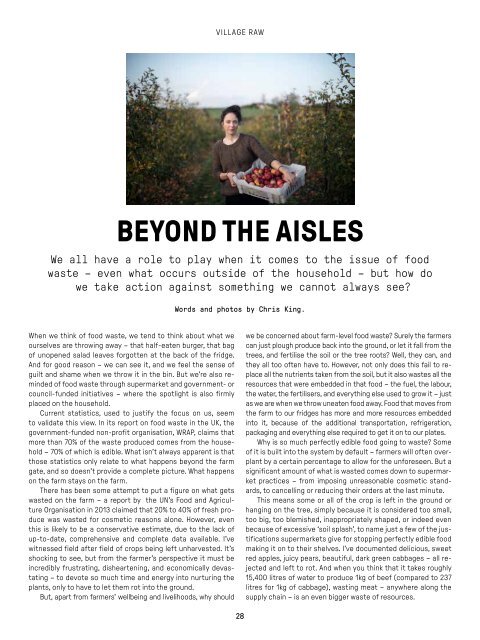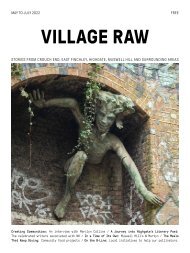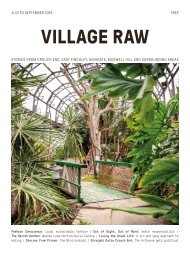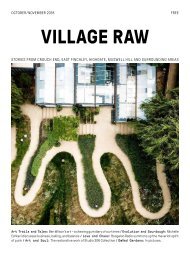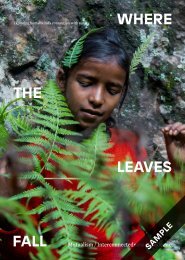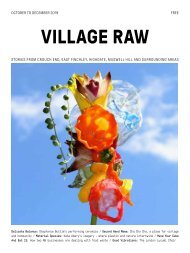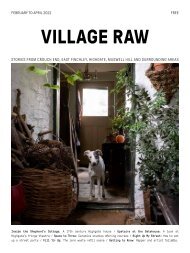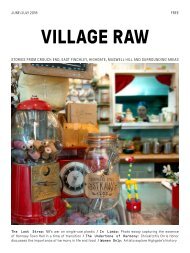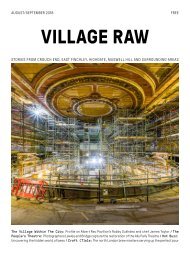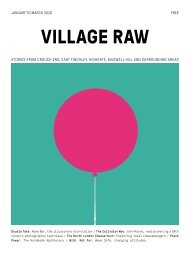Village Raw - ISSUE 4
Village Raw is a magazine that explores cultural stories from Crouch End, East Finchley, Highgate, Muswell Hill and the surrounding areas. The magazine is created by the community, for the community. If you like this issue you can support the project through a subscription or donation. See the links below. The fourth issue of Village Raw magazine includes: THE PYTHONS, A JABBERWOCKY, AND ME - Valerie Charlton on creatures, courses and the need to fail. A LEAP INTO THE UNKNOWN - Artist and dancer Jo Cork’s work with film. SATURN RETURNS - Yazmyn Hendrix - an a cappella artist who sees her music. THE NEXT MEAL - Local initiatives to help the homeless. A NEW ERA FOR HORNSEY TOWN HALL - Looking to the future. A TRUE INDEPENDENT - The Phoenix Cinema is one of the oldest independents in the UK. SECRETS OF A PERSIAN KITCHEN - A collection of recipes has been brewing in Atoosa Sepehr’s home. A TALE OF TWO DISTILLERIES - A look at two local gin-makers bringing mother’s ruin home again. BEYOND THE AISLES - The problem of farm-level food waste. VILLAGE ESSAY - The importance of local government. VILLAGE GREEN - The Guerrilla Gardeners of Palace Gates. AND MORE… Village Raw is created by the community, for the community. If you like this issue you can support the project through a subscription or donation. See the links below.
Village Raw is a magazine that explores cultural stories from Crouch End, East Finchley, Highgate, Muswell Hill and the surrounding areas. The magazine is created by the community, for the community. If you like this issue you can support the project through a subscription or donation. See the links below. The fourth issue of Village Raw magazine includes:
THE PYTHONS, A JABBERWOCKY, AND ME - Valerie Charlton on creatures, courses and the need to fail.
A LEAP INTO THE UNKNOWN - Artist and dancer Jo Cork’s work with film.
SATURN RETURNS - Yazmyn Hendrix - an a cappella artist who sees her music.
THE NEXT MEAL - Local initiatives to help the homeless.
A NEW ERA FOR HORNSEY TOWN HALL - Looking to the future.
A TRUE INDEPENDENT - The Phoenix Cinema is one of the oldest independents in the UK.
SECRETS OF A PERSIAN KITCHEN - A collection of recipes has been brewing in Atoosa Sepehr’s home.
A TALE OF TWO DISTILLERIES - A look at two local gin-makers bringing mother’s ruin home again.
BEYOND THE AISLES - The problem of farm-level food waste.
VILLAGE ESSAY - The importance of local government.
VILLAGE GREEN - The Guerrilla Gardeners of Palace Gates.
AND MORE…
Village Raw is created by the community, for the community. If you like this issue you can support the project through a subscription or donation. See the links below.
You also want an ePaper? Increase the reach of your titles
YUMPU automatically turns print PDFs into web optimized ePapers that Google loves.
VILLAGE RAW<br />
SUSTAINABLE VILLAGE<br />
BEYOND THE AISLES<br />
We all have a role to play when it comes to the issue of food<br />
waste – even what occurs outside of the household – but how do<br />
we take action against something we cannot always see?<br />
Words and photos by Chris King.<br />
When we think of food waste, we tend to think about what we<br />
ourselves are throwing away – that half-eaten burger, that bag<br />
of unopened salad leaves forgotten at the back of the fridge.<br />
And for good reason – we can see it, and we feel the sense of<br />
guilt and shame when we throw it in the bin. But we’re also reminded<br />
of food waste through supermarket and government- or<br />
council-funded initiatives – where the spotlight is also firmly<br />
placed on the household.<br />
Current statistics, used to justify the focus on us, seem<br />
to validate this view. In its report on food waste in the UK, the<br />
government-funded non-profit organisation, WRAP, claims that<br />
more than 70% of the waste produced comes from the household<br />
– 70% of which is edible. What isn’t always apparent is that<br />
those statistics only relate to what happens beyond the farm<br />
gate, and so doesn’t provide a complete picture. What happens<br />
on the farm stays on the farm.<br />
There has been some attempt to put a figure on what gets<br />
wasted on the farm – a report by the UN’s Food and Agriculture<br />
Organisation in 2013 claimed that 20% to 40% of fresh produce<br />
was wasted for cosmetic reasons alone. However, even<br />
this is likely to be a conservative estimate, due to the lack of<br />
up-to-date, comprehensive and complete data available. I’ve<br />
witnessed field after field of crops being left unharvested. It’s<br />
shocking to see, but from the farmer’s perspective it must be<br />
incredibly frustrating, disheartening, and economically devastating<br />
– to devote so much time and energy into nurturing the<br />
plants, only to have to let them rot into the ground.<br />
But, apart from farmers’ wellbeing and livelihoods, why should<br />
we be concerned about farm-level food waste? Surely the farmers<br />
can just plough produce back into the ground, or let it fall from the<br />
trees, and fertilise the soil or the tree roots? Well, they can, and<br />
they all too often have to. However, not only does this fail to replace<br />
all the nutrients taken from the soil, but it also wastes all the<br />
resources that were embedded in that food – the fuel, the labour,<br />
the water, the fertilisers, and everything else used to grow it – just<br />
as we are when we throw uneaten food away. Food that moves from<br />
the farm to our fridges has more and more resources embedded<br />
into it, because of the additional transportation, refrigeration,<br />
packaging and everything else required to get it on to our plates.<br />
Why is so much perfectly edible food going to waste? Some<br />
of it is built into the system by default – farmers will often overplant<br />
by a certain percentage to allow for the unforeseen. But a<br />
significant amount of what is wasted comes down to supermarket<br />
practices – from imposing unreasonable cosmetic standards,<br />
to cancelling or reducing their orders at the last minute.<br />
This means some or all of the crop is left in the ground or<br />
hanging on the tree, simply because it is considered too small,<br />
too big, too blemished, inappropriately shaped, or indeed even<br />
because of excessive ‘soil splash’, to name just a few of the justifications<br />
supermarkets give for stopping perfectly edible food<br />
making it on to their shelves. I’ve documented delicious, sweet<br />
red apples, juicy pears, beautiful, dark green cabbages – all rejected<br />
and left to rot. And when you think that it takes roughly<br />
15,400 litres of water to produce 1kg of beef (compared to 237<br />
litres for 1kg of cabbage), wasting meat – anywhere along the<br />
supply chain – is an even bigger waste of resources.<br />
28 29


